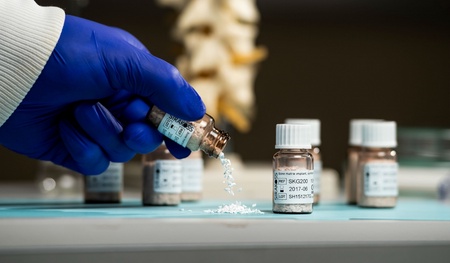In a development that represents new hope for repairing challenging bone fractures, a University spinout has received a CE mark for a synthetic bone graft substitute.
SIRAKOSS Ltd has announced it has been granted CE Mark clearance in the European Union (EU) for Osteo3, the nanosynthetic bone graft substitute designed to improve patient healing.
The CE marking is a certification mark that indicates conformity with health, safety, and environmental protection standards for products sold within the European Economic Area (EEA). This new technology has been designed to provide patients with more complete healing as well as allowing less time under anaesthesia, when it is launched into hospitals.
SIRAKOSS, which spun out from The University of Aberdeen in 2011 is a developer of synthetic bone graft substitutes that are designed to transform the treatment of spinal fusions and bone defects. This offers surgeons a more advanced solution for repairing bone fractures. Synthetic bone grafts are used to fuse bones together during surgery to correct congenital or degenerative conditions, such as curvature of the spine, or following a traumatic injury where the bone fails to heal.
Based on proprietary nanoporous technology, Osteo3 consists of an inorganic matrix that is completely reabsorbed into the bone. Osteo3 has a unique surface chemistry designed to catalyse rapid and complete bone regeneration following a fracture or to support the skeletal system after corrective surgery of a degenerative or deformity condition. SIRAKOSS is developing further generations of Osteo3 to facilitate intraoperative ease of use by surgeons.
“Osteo3 is the first of our new generation of bone substitute products to receive CE Mark, a major milestone for SIRAKOSS. We believe our approach could provide the definitive synthetic bone graft product and feedback from surgeons on performance has been very encouraging,” said Tom Buckland, Director of SIRAKOSS. “The positive results in studies achieved to date suggests that Osteo3 is a potential game-changer in the synthetic bone graft substitute market, providing significant advantages to patients and surgeons, including in the most challenging bone fracture indications. SIRAKOSS’ priority is executing on its commitment to delivering robust clinical data demonstrating safety and effectiveness of this exciting new product.”
Under its CE Mark, Osteo3 is intended to be used as a bone graft material for filling voids or gaps of the skeletal system. Osteo3 can be used alone or in combination with autograft, the patient’s own bone, or allograft (donor tissue).
“We designed Osteo3 to address an increasing demand for a bone graft substitute that has the efficacy of autograft but overcomes the well reported problems of donor site pain for a significant number of patients,” explained Iain Gibson, co-founder and Director of R&D at SIRAKOSS and Professor of Acellular Regenerative Medicine at the University of Aberdeen. “Our initial studies have confirmed both of these important aspects with our novel, fully nanosynthetic material. We are also working on the next generation of Osteo3, which will provide additional benefits to surgeons, in particular little or no prep in the surgical suite.”


